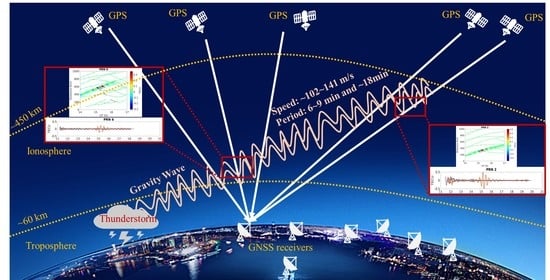Observation of Ionospheric Gravity Waves Introduced by Thunderstorms in Low Latitudes China by GNSS
Abstract
:1. Introduction
2. Data
2.1. GNSS Raw Data
2.2. Lightning Data
2.3. Kp and Dst Index
3. Methods
3.1. Extraction of Ionospheric Disturbances
3.2. Extraction of Ionospheric Gravity Waves
3.3. GW Period with Propagation Distance
4. Results
4.1. Extraction of GWs from Time Series
4.2. Location of Thunderstorms and GWs
4.3. GW Propagation Direction
4.4. Properties of the Gravity Wave Period
4.5. The Relationship between GW Propagation Distance and Period
4.6. Properties of the Propagation Velocity of Perturbation
5. Discussion
5.1. Extraction Methods of Gravity Waves and the Observability at Low Latitudes
5.2. Periodic Characteristics and Perturbation Magnitudes
5.3. Properties of the Propagation Speed
6. Conclusions
Author Contributions
Funding
Institutional Review Board Statement
Informed Consent Statement
Data Availability Statement
Acknowledgments
Conflicts of Interest
References
- Yang, L.; Fu, L.; Wang, J.; Zhang, C. Studying Ionosphere Responses to a Geomagnetic Storm in June 2015 with Multi-Constellation Observations. Remote Sens. 2018, 10, 666. [Google Scholar]
- Yasyukevich, Y.; Vasilyev, R.; Ratovsky, K.; Setov, A.; Globa, M.; Syrovatskii, S.; Yasyukevich, A.; Kiselev, A.; Vesnin, A. Small-Scale Ionospheric Irregularities of Auroral Origin at Mid-latitudes during the 22 June 2015 Magnetic Storm and Their Effect on GPS Positioning. Remote Sens. 2020, 12, 1579. [Google Scholar] [CrossRef]
- Vadas, S.L.; Azeem, I. Concentric Secondary Gravity Waves in the Thermosphere and Ionosphere Over the Continental United States on March 25–26, 2015 From Deep Convection. J. Geophys. Res. Space Phys. 2021, 126, 028275. [Google Scholar] [CrossRef]
- Zhai, C.; Yao, Y.; Kong, J. Three-dimensional reconstruction of seismo-traveling ionospheric disturbances after March 11, 2011, Japan Tohoku earthquake. J. Geod. 2021, 95, 1–12. [Google Scholar] [CrossRef]
- Freeshah, M.; Zhang, X.; Şentürk, E.; Adil, M.; Mousa, B.; Tariq, A.; Ren, X.; Refaat, M. Analysis of Atmospheric and Ionospheric Variations Due to Impacts of Super Typhoon Mangkhut (1822) in the Northwest Pacific Ocean. Remote Sens. 2021, 13, 661. [Google Scholar] [CrossRef]
- Erin, L.; Shao, X.M.; Kendrick, A.K.; Carrano, C.S. Ionospheric acoustic and gravity waves associated with midlatitude thunderstorms. J. Geophys. Res. Space Phys. 2015, 120, 6010–6020. [Google Scholar]
- Lay, E.H.; Shao, X.-M.; Carrano, C.S. Variation in total electron content above large thunderstorms. Geophys. Res. Lett. 2013, 40, 1945–1949. [Google Scholar] [CrossRef]
- Shao, X.-M.; Lay, E.H. The origin of infrasonic ionosphere oscillations over tropospheric thunderstorms. J. Geophys. Res. Space Phys. 2016, 121, 6783–6798. [Google Scholar] [CrossRef] [Green Version]
- Erin, H.L. Ionospheric Irregularities and Acoustic/Gravity Wave Activity Above Low-Latitude Thunderstorms. Geophys. Res. Lett. 2018, 45, 90–97. [Google Scholar]
- Tang, L.; Chen, W.; Louis, O.-P. Statistical Observation of Thunderstorm-Induced Ionospheric Gravity Waves above Low-Latitude Areas in the Northern Hemisphere. Remote Sens. 2019, 11, 2732. [Google Scholar] [CrossRef] [Green Version]
- Kumar, S.; Chen, W.; Liu, Z.; Singh, R.P. Thunderstorm-/lightning-induced ionospheric perturbation: An observation from equatorial and low-latitude stations around Hong Kong. J. Geophys. Res. Space Phys. 2017, 122, 9032–9044. [Google Scholar] [CrossRef]
- Ogunsua, B.O.; Srivastava, A.; Bian, J.; Qie, X.; Wang, D.; Jiang, R.; Yang, J. Significant Day-time Ionospheric Perturbation by Thunderstorms along the West African and Congo Sector of Equatorial Region. Sci. Rep. 2020, 10, 8466. [Google Scholar] [CrossRef]
- Jian, K.; Yao, Y.; Xu, Y.; Kuo, C.; Zhang, L.; Liu, L.; Zhai, C. A clear link connecting the troposphere and ionosphere: Ionospheric reponses to the 2015 Typhoon Dujuan. J. Geod. 2017, 91, 1087–1097. [Google Scholar]
- Chen, J.; Zhang, X.; Ren, X.; Zhang, J.; Freeshah, M.; Zhao, Z. Ionospheric disturbances detected during a typhoon based on GNSS phase observations: A case study for typhoon Mangkhut over Hong Kong. Adv. Space Res. 2020, 66, 1743–1753. [Google Scholar] [CrossRef]
- Wen, Y.; Jin, S. Traveling Ionospheric Disturbances Characteristics during the 2018 Typhoon Maria from GPS Observations. Remote Sens. 2020, 12, 746. [Google Scholar] [CrossRef] [Green Version]
- Wen, Y.; Zhang, Q.; Xu, J.; Li, Q.; Gao, H. Propagation characteristics of mesospheric concentric gravity waves excited by a thunderstorm. Chin. J. Geophys. 2019, 62, 1218–1229. [Google Scholar]
- Savastano, G.; Komjathy, A.; Verkhoglyadova, O.; Mazzoni, A.; Crespi, M.; Wei, Y.; Mannucci, A.J. Real-Time Detection of Tsunami Ionospheric Disturbances with a Stand-Alone GNSS Receiver: A Preliminary Feasibility Demonstration. Sci. Rep. 2017, 7, 46607. [Google Scholar] [CrossRef]
- Cai, C.; Liu, Z.; Xia, P.; Dai, W. Cycle slip detection and repair for undifferenced GPS observations under high ionospheric activity. GPS Solut. 2012, 17, 247–260. [Google Scholar] [CrossRef]
- Haaser, R.; Lay, E.H.; Junor, W. Analysis framework for systematically studying ionospheric response to impulsive events from below. Radio Sci. 2017, 52, 1149–1169. [Google Scholar] [CrossRef]
- Hines, C.O. Internal atmospheric gravity waves at ionospheric heights. Can. J. Phys. 1960, 38, 1424–1427. [Google Scholar] [CrossRef]
- Fritts, D.C.; Alexander, M.J. Correction to “Gravity wave dynamics and effects in the middle atmosphere”. Rev. Geophys. 2012, 50, RG3004. [Google Scholar] [CrossRef]
- Vadas, S.L.; Liu, H.-L. Generation of large-scale gravity waves and neutral winds in the thermosphere from the dissipation of convectively generated gravity waves. J. Geophys. Res. Space Phys. 2009, 114, A10310. [Google Scholar] [CrossRef]
- Nayak, C.; Yiit, E. GPS-TEC Observation of Gravity Waves Generated in the Ionosphere During 21 August 2017 Total Solar Eclipse. J. Geophys. Res. Space Phys. 2018, 123, 725–738. [Google Scholar] [CrossRef] [Green Version]
- Stockwell, R.G.; Mansinha, L.; Lowe, R.P. Localization of the complex spectrum: The S transform. IEEE Trans. Signal Process. 1996, 44, 998–1001. [Google Scholar] [CrossRef]
- Freeshah, M.A.A.; Zhang, X.; Chen, J.; Zhao, Z.; Osama, N.; Sadek, M.; Twumasi, N. Detecting Ionospheric TEC Disturbances by Three Methods of Detrending through Dense CORS During A Strong Thunderstorm. Ann. Geophys. 2020, 63, 667. [Google Scholar] [CrossRef]
- Yang, H.; Moreno, E.M.; Hernández-Pajares, M. ADDTID: An Alternative Tool for Studying Earthquake/Tsunami Signatures in the Ionosphere. Case of the 2011 Tohoku Earthquake. Remote Sens. 2019, 11, 1894. [Google Scholar] [CrossRef] [Green Version]
- Wu, K.; Xu, J.; Wang, W.; Sun, L.; Yuan, W. Interaction of Oppositely Traveling Medium-scale Traveling Ionospheric Disturbances Observed in Low Latitudes During Geomagnetically Quiet Nighttime. J. Geophys. Res. Space Phys. 2020, 126, e2020JA028723. [Google Scholar]
- Bhat, A.H.; Ganaie, B.A.; Ramkumar, T.K.; Chaitanya, P.P.; Malik, M.A. Simultaneous detection of medium-scale traveling ionospheric disturbances and ionospheric plasma irregularities over Srinagar, J&K, India. Acta Geophys. 2021, 69, 1–15. [Google Scholar] [CrossRef]
- Narayanan, V.L.; Patra, A.K.; Gurubaran, S.; Chaitanya, P.P.; Emperumal, K. Coincident Airglow, VHF Radar, and Ionosonde Observations of Electrified Medium-Scale Traveling Ionospheric Disturbances in the Equatorial Latitudes. Geophys. Res. Lett. 2019, 46, 7173–7181. [Google Scholar] [CrossRef]
- Jonah, O.F.; Zhang, S.; Coster, A.J.; Goncharenko, L.P.; Erickson, P.J.; Rideout, W.; de Paula, E.R.; de Jesus, R. Understanding Inter-Hemispheric Traveling Ionospheric Disturbances and Their Mechanisms. Remote Sens. 2020, 12, 228. [Google Scholar] [CrossRef] [Green Version]
- Vadas, S.L.; Nicolls, M.J. Temporal evolution of neutral, thermospheric winds and plasma response using PFISR measurements of gravity waves. J. Atmos. Solar-Terr. Phys. 2009, 71, 744–770. [Google Scholar] [CrossRef]
- Oinats, A.V.; Nishitani, N.; Ponomarenko, P.; Berngardt, O.; Ratovsky, K.G. Statistical characteristics of medium-scale traveling ionospheric disturbances revealed from the Hokkaido East and Ekaterinburg HF radar data. Earth Planets Space 2016, 68, 8. [Google Scholar] [CrossRef] [Green Version]
- Chou, C.-C.; Dai, J.; Kuo, C.-L.; Huang, T.-Y. Simultaneous observations of storm-generated sprite and gravity wave over Bangladesh. J. Geophys. Res. Space Phys. 2016, 121, 9222–9233. [Google Scholar] [CrossRef]
- Rahmani, Y.; Alizadeh, M.M.; Schuh, H.; Wickert, J.; Tsai, L.-C. Probing vertical coupling effects of thunderstorms on lower ionosphere using GNSS data. Adv. Space Res. 2020, 66, 1967–1976. [Google Scholar] [CrossRef]
- Abdu, M.A.; Pancheva, D. Aeronomy of the Earth’s Atmosphere and Ionosphere; IAGA Special Sopron Book Series; Abdu, M.A., Pancheva, D., Bhattacharyya, A., Eds.; Springer: Berlin/Heidelberg, Germany, 2011. [Google Scholar]
- Kuo, C.L.; Lee, L.C. Ionospheric plasma dynamics and instability caused by upward currents above thunderstorms. J. Geophys. Res. Space Phys. 2015, 120, 3240–3253. [Google Scholar] [CrossRef] [Green Version]
- Vadas, S.L.; Liu, H.-L. Numerical modeling of the large-scale neutral and plasma responses to the body forces created by the dissipation of gravity waves from 6 h of deep convection in Brazil. J. Geophys. Res. Space Phys. 2013, 118, 2593–2617. [Google Scholar] [CrossRef]
- Song, Q.; Ding, F.; Zhang, X.; Liu, H.; Mao, T.; Zhao, X.; Wang, Y. Medium-Scale Traveling Ionospheric Disturbances Induced by Typhoon Chan-hom Over China. J. Geophys. Res. Space Phys. 2019, 124, 2223–2237. [Google Scholar] [CrossRef]
- Erin, L.; Parker, P.A.; Light, M.; Carrano, C.S.; Debchoudhury, S.; Haaser, R.A. Midlatitude Ionospheric Irregularity Spectral Density as Determined by Ground-Based GPS Receiver Networks. J. Geophys. Res. Space Phys. 2018, 123, 5055–5067. [Google Scholar]
- Padokhin, A.; Tereshin, N.; Yasyukevich, Y.; Andreeva, E.; Nazarenko, M.; Yasyukevich, A.; Kozlovtseva, E.; Kurbatov, G. Application of BDS-GEO for studying TEC variability in equatorial ionosphere on different time scales. Adv. Space Res. 2018, 63, 257–269. [Google Scholar] [CrossRef]
- Huang, F.; Lei, J.; Otsuka, Y.; Luan, X.; Liu, Y.; Zhong, J.; Dou, X. Characteristics of Medium-Scale Traveling Ionospheric Disturbances and Ionospheric Irregularities at Mid-Latitudes Revealed by the Total Electron Content Associated With the Beidou Geostationary Satellite. IEEE Trans. Geosci. Remote Sens. 2020, 59, 1–7. [Google Scholar] [CrossRef]
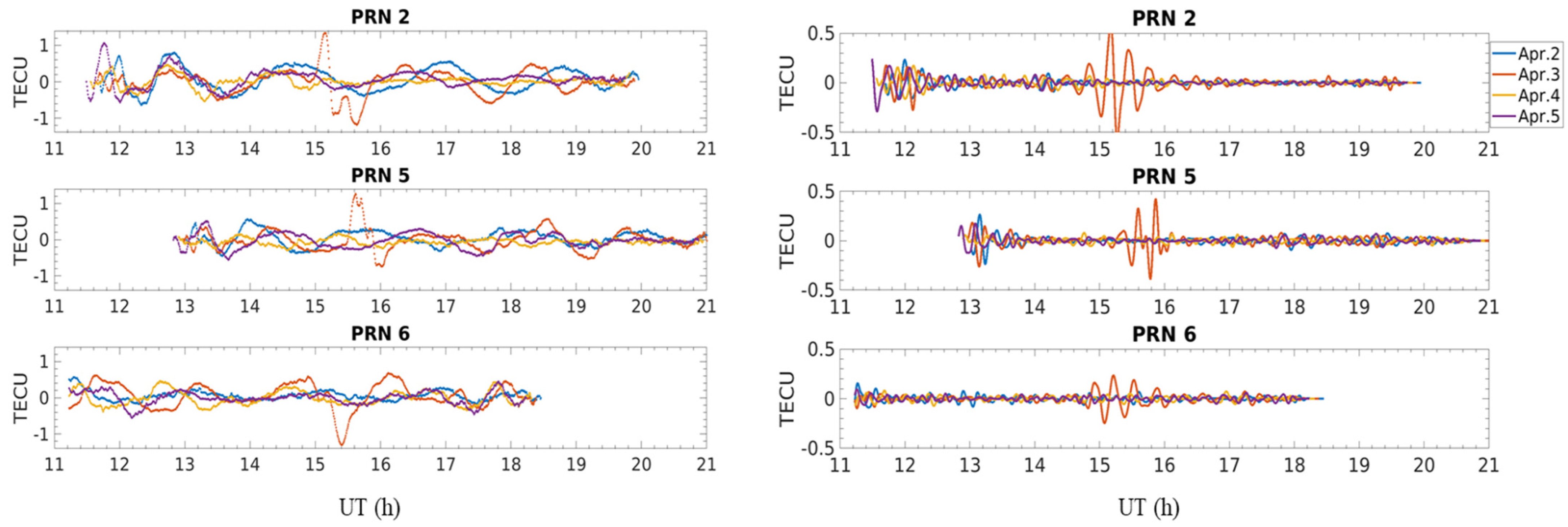


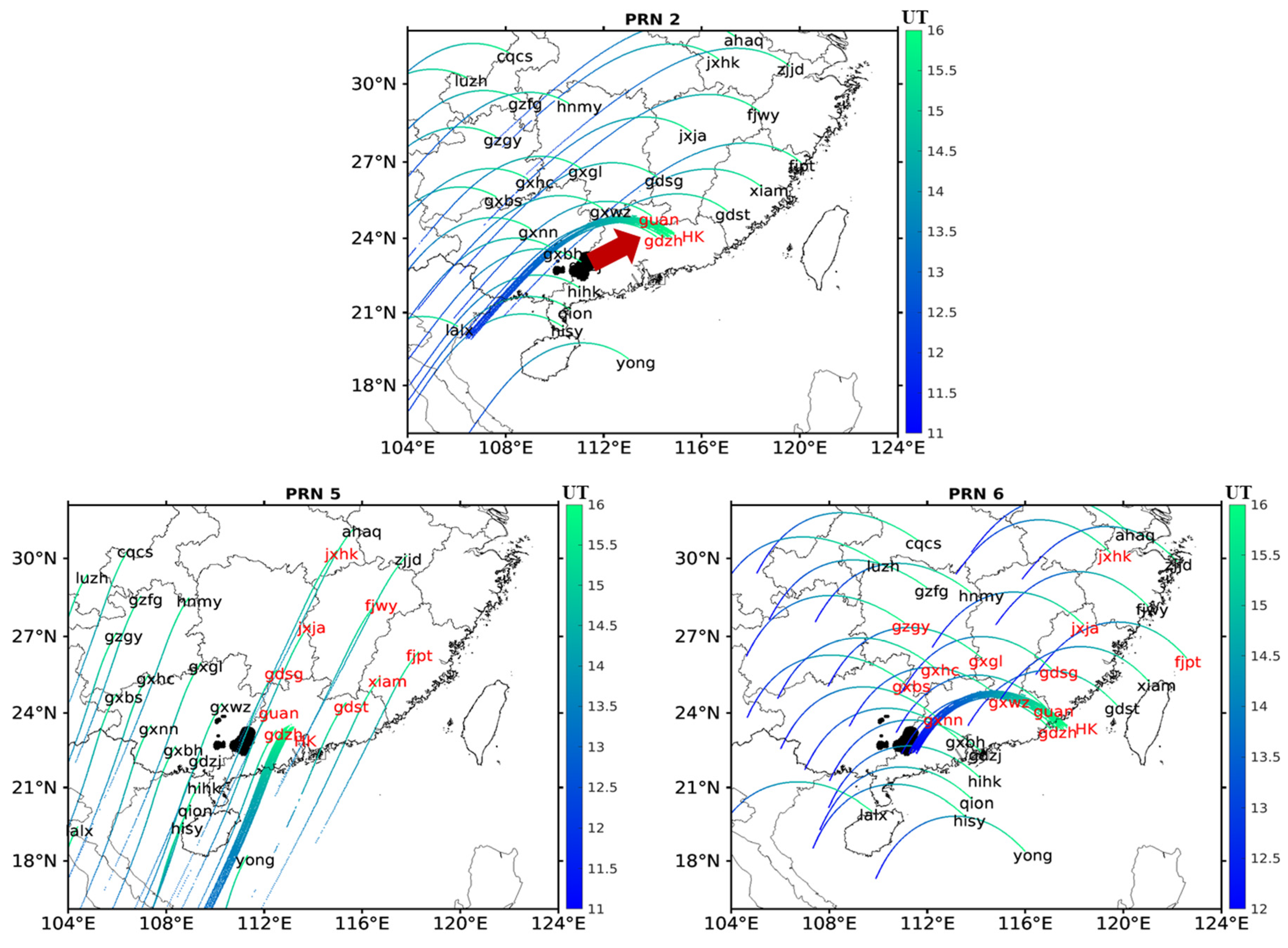
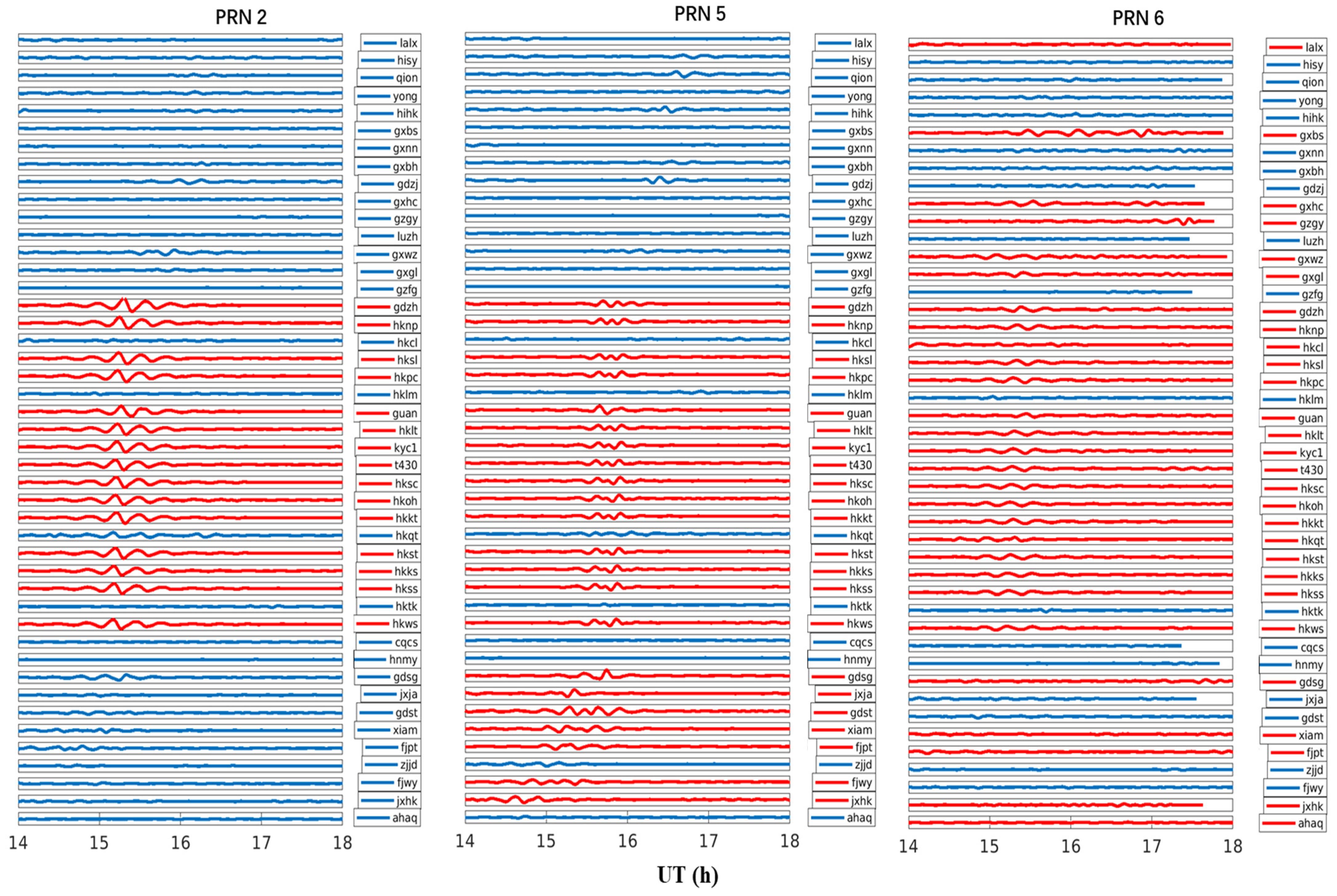
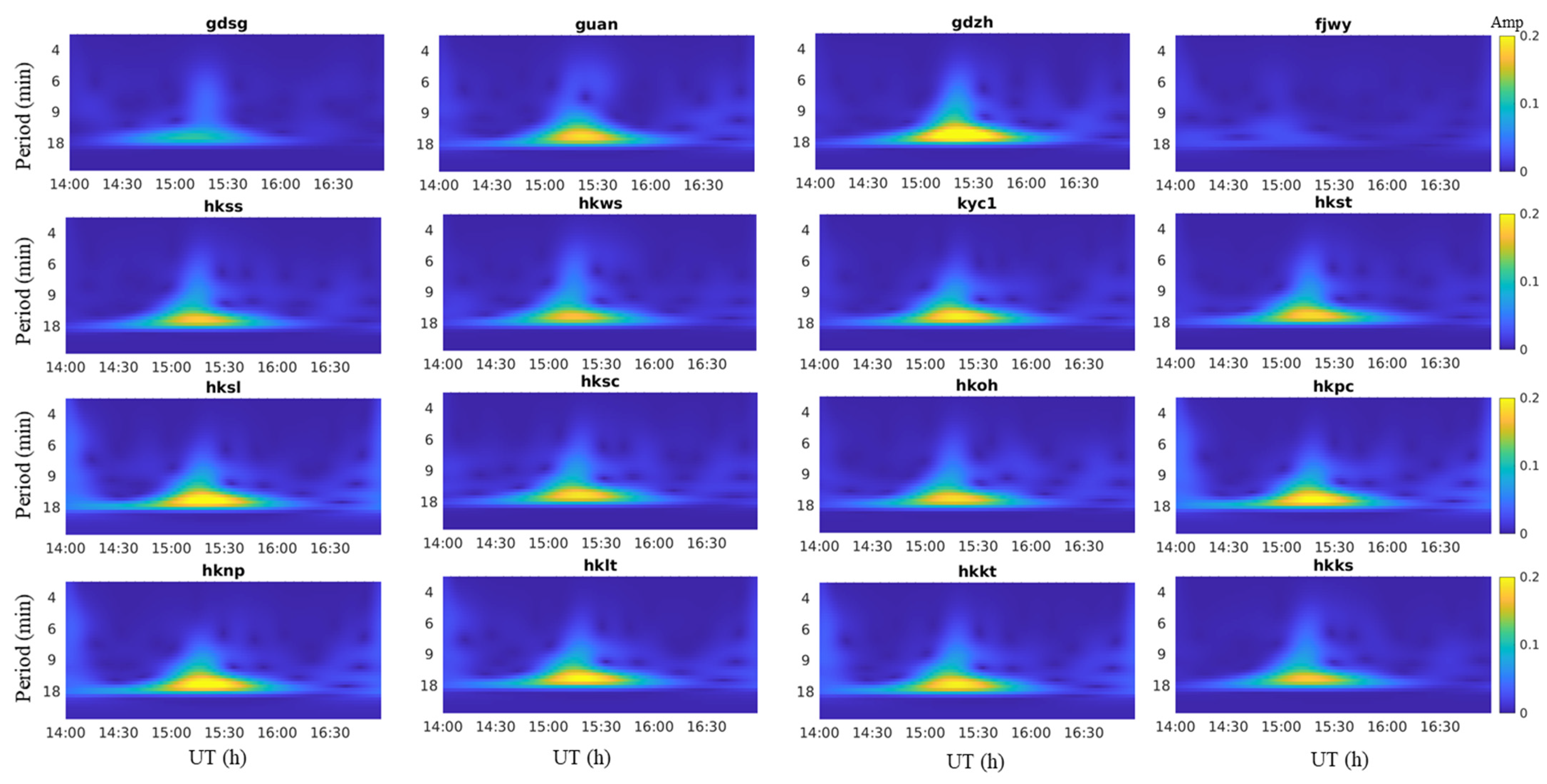
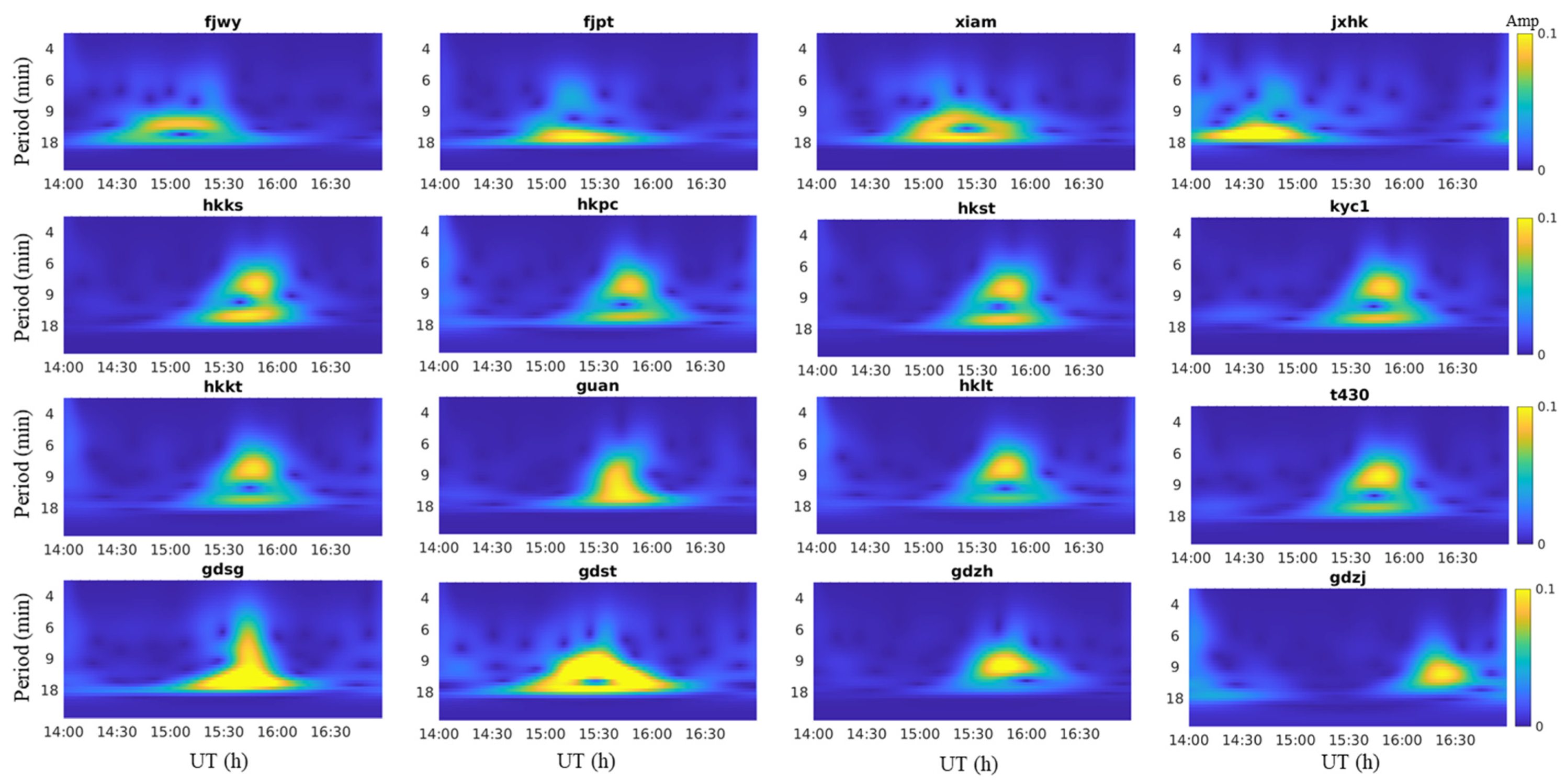

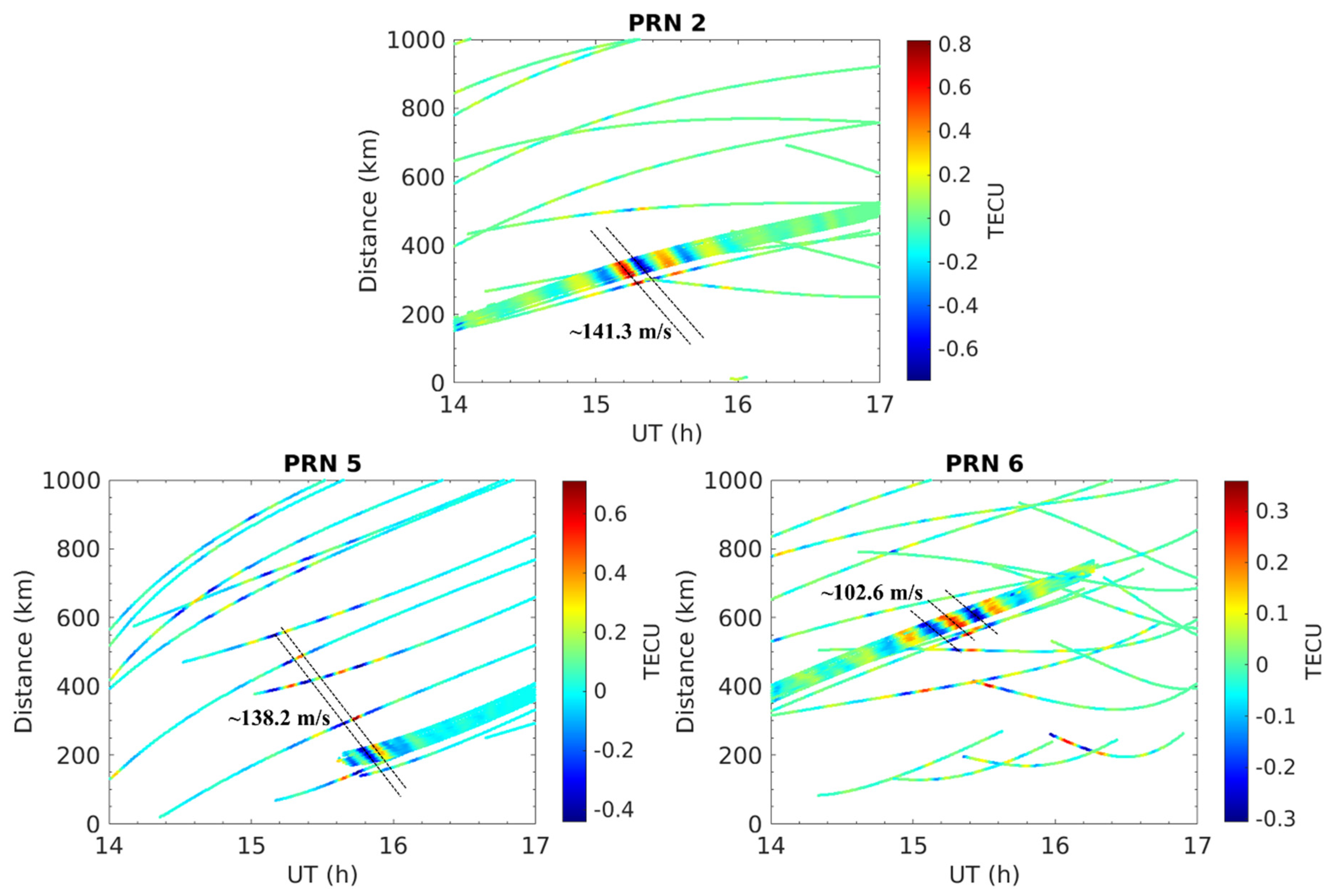
Publisher’s Note: MDPI stays neutral with regard to jurisdictional claims in published maps and institutional affiliations. |
© 2021 by the authors. Licensee MDPI, Basel, Switzerland. This article is an open access article distributed under the terms and conditions of the Creative Commons Attribution (CC BY) license (https://creativecommons.org/licenses/by/4.0/).
Share and Cite
Liu, T.; Yu, Z.; Ding, Z.; Nie, W.; Xu, G. Observation of Ionospheric Gravity Waves Introduced by Thunderstorms in Low Latitudes China by GNSS. Remote Sens. 2021, 13, 4131. https://doi.org/10.3390/rs13204131
Liu T, Yu Z, Ding Z, Nie W, Xu G. Observation of Ionospheric Gravity Waves Introduced by Thunderstorms in Low Latitudes China by GNSS. Remote Sensing. 2021; 13(20):4131. https://doi.org/10.3390/rs13204131
Chicago/Turabian StyleLiu, Tong, Zhibin Yu, Zonghua Ding, Wenfeng Nie, and Guochang Xu. 2021. "Observation of Ionospheric Gravity Waves Introduced by Thunderstorms in Low Latitudes China by GNSS" Remote Sensing 13, no. 20: 4131. https://doi.org/10.3390/rs13204131
APA StyleLiu, T., Yu, Z., Ding, Z., Nie, W., & Xu, G. (2021). Observation of Ionospheric Gravity Waves Introduced by Thunderstorms in Low Latitudes China by GNSS. Remote Sensing, 13(20), 4131. https://doi.org/10.3390/rs13204131






